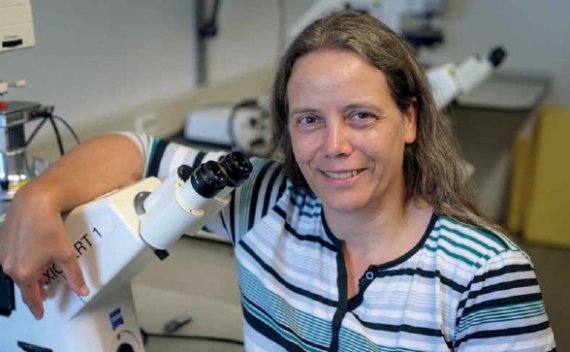Emulsions are mixtures of oil and water. Normally these two substances do not mix. But if you stir fast enough, the oil forms droplets in the water: an emulsion. And if you add substances to stabilize the mixture, the emulsion will stay intact for a while. Our daily food is full of emulsions. Did you eat any ice creams this summer? Ice cream consists of a lot of air bubbles that ‘float’ in crystals of milk fat enclosed in protein and sugar. An awful lot of air bubbles. Up to half of an ice cream consists of air. Making ice cream starts with an emulsion of droplets of milk fat in the rest of the ice cream mix. Then air is added and the mixture is chilled. That is basically how ice cream works. But we know extraordinarily little about the details, says the new professor holding a personal chair, Karin Schroën. The preparation of ice cream is largely a question of tradition, craft and experience. In other words, trial and error. That applies to a lot of food products. We know how to make them but what happens on the small scale is largely a mystery. That scale is the micro-world, the world where the units are thousandths of millimetres. The microscale is Schroën’s world. It is the future for our food, as she said provocatively in the title of her inaugural lecture – Fast Forward for Food’s Future – just before the summer holiday.
Microscale
Schroën and her group (currently eight PhD students, a postdoc and an assistant professor) have been doing pioneering work in this uncharted territory for a decade. Hunting for the perfect droplet. One of their gems is the EDGE droplet technique; Edge-based Droplet Generation. Creating droplets on the edge. The process takes place on a microchip. On this droplet chip, the oil is pressed onto a plate via a narrow channel. On the edge of the plate, droplets form in a flow of water. Hey presto, an emulsion. Schroën’s droplets are extremely uniform: their dimensions vary by no more than five per cent. Schroën: ‘The nice thing about this technique is that the droplet size depends only on the height of the plate: the droplets are six times that height. There are only a couple of parameters that influence that process: the pressure on the oil, the oil’s interfacial tension and the contact angle between the oil droplet and the water. That’s why it is so useful. We know exactly how many droplets are formed per second and how large they are. We understand the process. We can also reproduce it in simulation models. That is important: in our work, experiments and simulation go hand in hand.’
It is basically as simple as it sounds. But then on a microscale. The chip plate measures 200×100 micrometres. The chip produces thousands of droplets per second with the desired dimensions, but you cannot see them with the naked eye. Schroën uses ultra-fast cameras to track things. ‘We’ve just got a new one that can take up to 100,000 pictures per second. As each clip can be four gigabytes, you can only film for a couple of seconds.’ The key thing is that microscale. According to Schroën, things happen on that scale that you do not see at a bigger scale. ‘If you work at the millimetre level, you don’t get droplets; the oil just flows over the edge. Then you are looking at flow theory. We are really looking for very unusual process conditions.’
Scaling up
So Schroën can produce high-tech emulsions. But is there any benefit to this? Definitely, she thinks. ‘Quite apart from a better understanding of the processes, this results in new products where we can make better use of all the available ingredients.’ Furthermore, it costs far less energy to make emulsions using microchips. The industry currently produces emulsions by pushing liquids through a narrow opening at high pressure. About 95 per cent of the energy used is lost. Schroën: ‘Take the example of ice cream. Our method for making emulsions reduces energy consumption by a factor of between ten and a hundred. We also use less raw materials. So we achieve more with less.’ Her emulsions are probably also physically more stable, which means food products with a longer shelf life. That could be a decisive argument in the fight to reduce food waste.
But still only at the microscale as yet. And that is an important problem: how to scale up the process. The industry wants bulk production. Schroën: ‘Now, all emulsions are made using homogenizers. If you want to replace that with this technique, the scaled-up version needs to work well and be cheaper. You need to be able to cope with high-volume flows. The problem with EDGE is that it is a slow process. The droplets don’t form that quickly. You need quite a few chips to produce one cubic unit of emulsion. To scale up, we are currently using the chips in parallel, putting a whole load of them next to each other.’ And then there is the unpredictable consumer. Do we even want high-tech food? ‘Acceptance by consumers is really important,’ says Schroën. ‘You can produce radically different products that seem very unfamiliar to consumers, but such products will not catch on. Whether food is accepted depends a lot on cultural factors.’
Photo: Guy Ackermans

